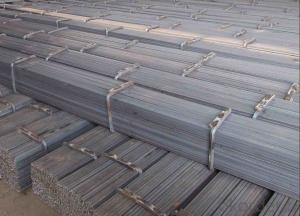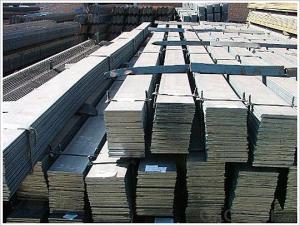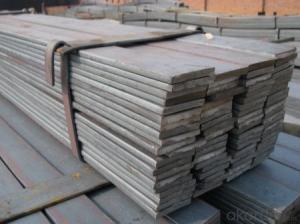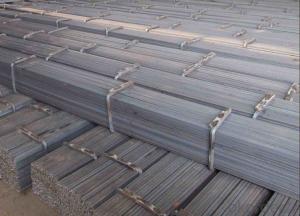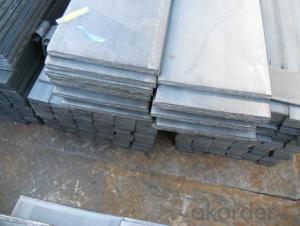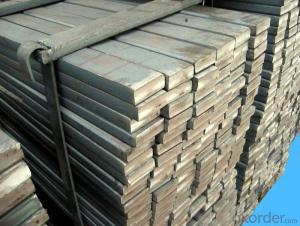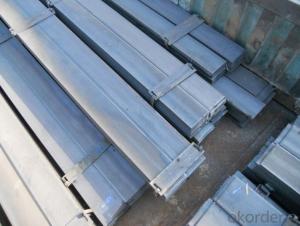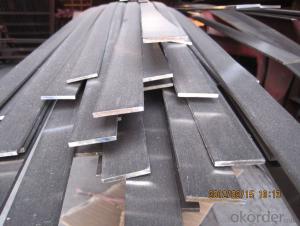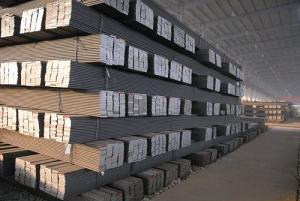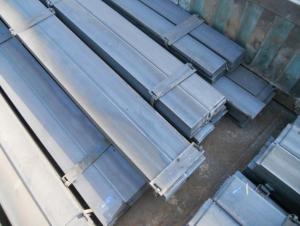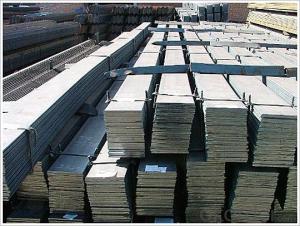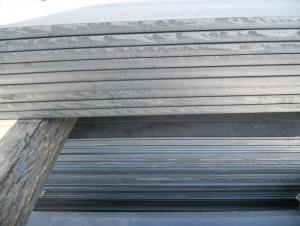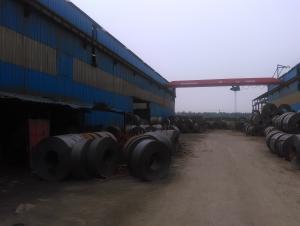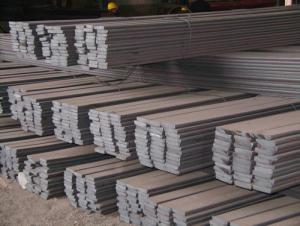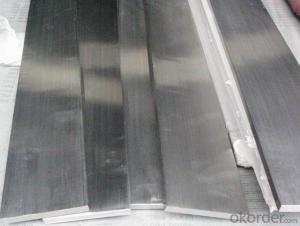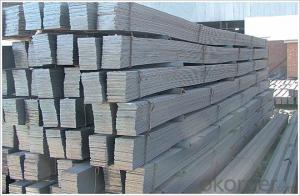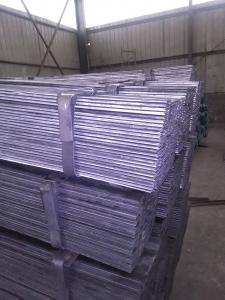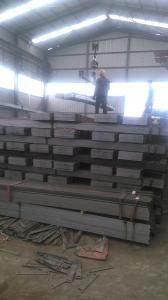FLAT BAR 20-200
- Loading Port:
- China Main Port
- Payment Terms:
- TT OR LC
- Min Order Qty:
- -
- Supply Capability:
- -
OKorder Service Pledge
OKorder Financial Service
You Might Also Like
Product Description:
Product Description:
Specification of Mild Steel Flat Bar
Commodity: Mild Steel Flat Bar
Standard: GB;JIS
Material: Q195-235;SS400
Brand name: FLATSPACE
Origin place: China
Thickness: 3mm-30mm
Width:20mm-200mm
Length: Max 12m
Certification: SGS/BV
Chemical composition of Q235
Alloy No | Grade | Element(%) | ||||
C
| Mn
| S
| P
| Si
| ||
Q235
|
B
|
0.12—0.20 |
0.3—0.7 |
≤0.045 |
≤0.045
|
≤0.3
|
Physical properties of Q235
Alloy No | Grade | Yielding strength point(Mpa) | Tensile strength (Mpa) | Elongation after fracture(%) | ||||||
Thickness (mm) | Thickness (mm) | |||||||||
≤16 | >16--40 | >40--60 | >60--100 |
| ≤16 | >16--40 | >40--60 | >60--100 | ||
≥ | ≥ | |||||||||
Q235 |
B |
235 |
225 |
215 |
205 |
375--500 |
26 |
25 |
24 |
23 |
Usage/Applications of Mild Steel Flat Bar
Widely used for construction, Machinery manufacturing, Iron tower steel structure, Shipbuilding; Steel grating, Staircase, Bridge, Viaduct, Railway spare parts, Boilers making etc.
Packaging & Delivery of Mild Steel Flat Bar
Packaging Details: The Mild Steel Flat Bars are packed in bundles and loaded in 20 feet/40 feet container, or shipped by bulk cargo ,also we can do as customer's requirements.
Delivery Details:30~45 days upon the receipt of buyer payment by T.T. or L/C.
Production Flow of Mild Steel Flat Bar
The Mild steel flat bar is made through three processes:
1.Feeding the material: Feeding the row material (the steel plate) to Slitting Line.
2.Slitting:The steel plate would be slitted into expected width by lengthways cutter.
3. Leveled and cutting: The plat bar would be ground into level by the grinder and then cut into required length
- Q: How do you calculate the weight of a steel flat bar?
- To calculate the weight of a steel flat bar, you need to know its dimensions (length, width, and thickness) and the density of steel. The weight can be calculated by multiplying the volume (length x width x thickness) with the density of steel.
- Q: What are the different standards or specifications for steel flat bars?
- There are several different standards or specifications for steel flat bars, including ASTM A36, ASTM A108, ASTM A529, and ASTM A572. These standards provide guidelines for the chemical composition, mechanical properties, and dimensions of steel flat bars, ensuring their quality and suitability for various applications. Other organizations, such as the British Standards Institution (BSI) and the International Organization for Standardization (ISO), also have their own standards for steel flat bars.
- Q: How do steel flat bars perform in terms of UV resistance?
- Steel flat bars lack inherent UV resistance properties, making them susceptible to negative effects when exposed to ultraviolet (UV) radiation from sunlight. Extended exposure to UV rays can cause degradation and brittleness in steel over time, resulting in discoloration, oxidation, and structural weaknesses in flat bars. To address these issues and enhance UV resistance, various methods can be utilized. One commonly employed approach involves applying protective coatings, such as paint or specialized finishes, to the steel surface. These coatings act as a barrier, shielding the steel from direct UV exposure and preventing degradation. Moreover, stainless steel flat bars tend to exhibit superior resistance to UV radiation compared to carbon steel. This is due to the presence of chromium in stainless steel, which forms a passive oxide layer offering some natural UV protection. However, it is important to note that even stainless steel can still be affected by intense UV rays when exposed for prolonged periods. Ultimately, when considering the use of steel flat bars in outdoor or UV-exposed applications, it is essential to carefully consider the specific environment, level of UV exposure, and the necessity for additional protective measures. These considerations are crucial for ensuring the longevity and performance of the steel flat bars.
- Q: What is the standard thickness of a steel flat bar?
- The standard thickness of a steel flat bar can vary depending on the specific application and industry standards. However, commonly available steel flat bars typically range in thickness from 1/8 inch to 1 inch. It is important to note that custom sizes and thicknesses are also available to meet specific requirements.
- Q: Can steel flat bars be used for making playground equipment?
- Yes, steel flat bars can be used for making playground equipment. Steel is a durable and strong material that can withstand heavy use and weather conditions, making it suitable for constructing various playground structures such as monkey bars, slides, and climbing frames.
- Q: How are steel flat bars measured?
- Steel flat bars are typically measured by their width and thickness. The width refers to the horizontal dimension of the bar, while the thickness refers to the vertical dimension. Both measurements are usually expressed in millimeters or inches. For example, a steel flat bar might be specified as 50 mm wide and 5 mm thick. These measurements help to determine the overall size and shape of the bar, allowing it to be accurately used in construction, manufacturing, or other applications.
- Q: Can steel flat bars be easily machined or drilled?
- Machining or drilling steel flat bars proves to be a simple task. Steel possesses remarkable machinability, allowing it to be effortlessly manipulated, sliced, or drilled using an array of tools and techniques. Steel flat bars, with their flat and uniform shape, particularly lend themselves to machining and drilling operations. One can easily work on them with drills, milling machines, lathes, or any other equipment commonly employed in metalworking. Nonetheless, it remains crucial to carefully select suitable cutting tools and speeds in accordance with the specific grade and hardness of the steel being machined. Moreover, incorporating appropriate coolant or lubrication during the machining process can effectively extend the lifespan of tools and enhance the overall quality of the finished product.
- Q: Can steel flat bars be used for making brackets or supports for automotive accessories?
- Yes, steel flat bars can be used for making brackets or supports for automotive accessories. Steel is a strong and durable material that provides excellent structural support. The flat shape of the bars allows for easy bending and shaping to fit specific dimensions and angles required for brackets or supports. Additionally, steel flat bars can be welded or bolted together, offering versatility in design and installation. Moreover, steel is resistant to corrosion, making it suitable for automotive applications where exposure to moisture or other elements is common. Overall, steel flat bars are a reliable and popular choice for creating brackets or supports for automotive accessories due to their strength, versatility, and durability.
- Q: Can steel flat bars be used for making storage shelves?
- Yes, steel flat bars can be used for making storage shelves. Steel flat bars are strong, durable, and able to support heavy loads, making them an ideal choice for storage shelves. They can be easily cut, welded, and shaped to create custom storage solutions. Additionally, steel flat bars are resistant to corrosion, which ensures that the shelves will maintain their structural integrity over time. Whether for industrial, commercial, or residential use, steel flat bars are a reliable and versatile option for making storage shelves.
- Q: What are the different packaging options for steel flat bars?
- There are several packaging options available for steel flat bars, depending on the specific requirements and preferences of the customer. One common packaging option is bundle packaging, where multiple steel flat bars are bundled together using steel straps or wire ties. This ensures that the bars are securely held together during transportation and storage. Bundle packaging is often used for smaller quantities of steel flat bars. For larger quantities, steel flat bars can be shipped in steel crates or pallets. These crates or pallets are typically made of steel or wood and provide additional protection to the bars during transit. They can be easily loaded and unloaded using forklifts or other handling equipment. Another packaging option is coil packaging, where the steel flat bars are coiled into a circular shape. This is commonly used for longer and thinner flat bars, as it allows for easier handling and reduces the risk of damage during transportation. Coil packaging is often used in industries such as construction and manufacturing. In addition to these options, steel flat bars can also be packaged in custom packaging solutions, tailored to meet specific requirements. This can include additional protective materials such as cardboard or plastic wrapping, foam inserts, or wooden crates, depending on the desired level of protection. Overall, the packaging options for steel flat bars are diverse and can be customized to suit the needs of different customers. The choice of packaging depends on factors such as the quantity, size, and shape of the flat bars, as well as the transportation and storage conditions.
Send your message to us
FLAT BAR 20-200
- Loading Port:
- China Main Port
- Payment Terms:
- TT OR LC
- Min Order Qty:
- -
- Supply Capability:
- -
OKorder Service Pledge
OKorder Financial Service
Similar products
Hot products
Hot Searches
Related keywords
